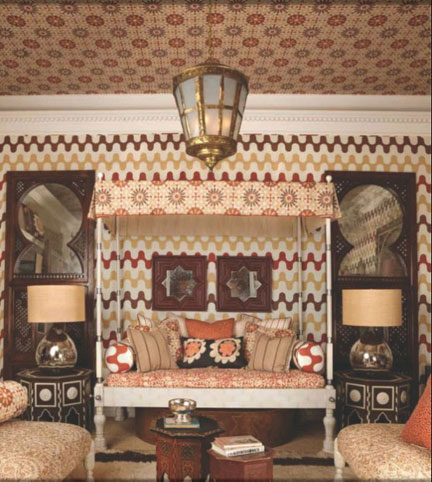Save to...
Who’s the Real Gatsby? Design and Architecture from the 1974 and 2013 Movies
The Great Gatsby will always get my vote for The Great American Novel. Here’s the tale of a man from humble roots who reinvents himself to pursue an idealized dream, a lost love from his youth. But what is Jay Gatsby like? What was going through his mind as he looked out from his mansion across the Long Island Sound night after night, thinking of Daisy?
Part of the answer can be found in the mansion, for our design choices speak volumes about ourselves. For the 1974 movie featuring Robert Redford, we see a grand Baroque-inspired mansion. If this looks like a Gilded Age mansion, it’s because it is one — the movie was filmed at Rosecliff in Newport, RI, which was modeled after the Grand Trianon in Versailles and shows the aspirations of the Nevada silver mining heiress who commissioned it:

And here are the ornate European interiors of the ballroom at Rosecliff:

I always thought this was the perfect house for Jay Gatsby. Having come from humble roots, he wanted to woo back Daisy by becoming someone else: the heir of an old wealthy family. What better way to do that than move right into the house of one?
Indeed that is the persona that Robert Redford played in the 1974 movie: A passive, if not pathetic, man trying to fit into a world that he did not belong in. He went to extremes to gather and show off his wealth, in the end he was just trying to fit in with the Buchanans. Notice the similarity of the Gatsby mansion to the Buchanans’ estate, Heatherden Hall:

Fast forward to 2013, and we find Leonardo di Caprio playing a different Gatsby: bolder, stronger, and more assertive. Here’s his mansion – a fantasy castle reminiscent of the mad Gothic style of Mad King Ludwig’s Neuschwanstein Castle in Bavaria:

In contrast, the Buchanans’ home is based on the Greek Revival style popular with the Old South aristocrats (think Gone with the Wind and Thomas Jefferson’s Monticello):

Now look at the interior. The Art Deco look of the famous “shirts” scene might look retro now, but it was in fact cutting edge Art Deco design in the 1920’s. Art Deco came into vogue in France during the 1920’s as an homage to the new Machine Age. It was a bold, assertive style of the future (think Chrysler Building and Fritz Lang’s Metropolis), not the past of Rosecliff.

We can also see a bold, Art Deco motif in the floor of the ballroom, along with Gatsby’s initials prominently in the center. Talk about leaving his mark on the world:

When we build, we create a world. What kind of world is it, and where do we belong in it? Even before the first stone is laid, we’ve already asked and answered those questions. Gatsby, unfettered by prosaic considerations of cost and resale value, could create anything he could envision. From what he created, we could peer down into the deepest reaches of his soul. Whereas Redford’s Gatsby was trying to inherit a past that was never his, di Caprio’s Gatsby loudly proclaims “Here I am!” Whereas Redford was timid and uncertain in front of Daisy and Tom, di Caprio has come to take what belongs to him.
How We Design Today: Contrasting Styles in Architectural Digest
Is there a defining design style today? The latest AD cover actually sums it up:

Look carefully, and you’ll notice a traditional chandelier:

On top of a very sleek, modern coffee table:

You see small bursts of exoticism and color, but the primary design is neutral and comfortable

Lest you take this for granted, take a look at what was on the cover of AD in 1970:

and 1971:

Back then, we had sharply divided design styles. You were either a Traditionalist or Modernist, and there was no mixing of the two styles. Neither style seemed very comfortable either — could you imagine hopping onto either silk or leather couch on these covers?
In contrast, today’s design has finally balanced both traditional and modern elements and made it all the more comfortable.
Do it Yourself: How to Install a Stair Runner

The classic stair runner is like an instant facelift for an old wooden staircase. It adds a touch of personality in an unexpected place. Our friends at Dash & Albert have shown us how to recreate this look with just a few simple steps.
What you’ll need:
Woven cotton or indoor/outdoor stair runner of your choice; measure your stairs first to determine the total length needed (see step 1)
2’ x 8’ rug pads; measure your stairs first to determine the total length needed (see step 1)
Fabric scissors
Pneumatic staple gun
3/8-inch to 1/2-inch staples
Tape measure
Yardstick or other straight edge
Double-stick carpet tape
Pencil
Marker
Bolster chisel
A little patience
How to do it:
1. To determine how long a runner you’ll need, measure the depth of the stair tread and the height of the riser. Multiply the total by the number of stairs; this is your total runner length.


2. Measure the width of the treads from end to end, or from end to banisters. Mark the middle with a pencil.


3. Create individual rug pads for each stair tread by fitting the top edge of the pad against the back of the tread and gently straightening it.

4. Mark the cut line on the pad about .5 inches from the front of the stair tread. (Note that the runner will be slightly wider than the rug pad, and thus the edges of the rug pad won’t peek out from underneath.) Cut the rug pad along the line with fabric scissors. Measure and cut as many rug pads as needed to cover all treads.
5. Cut three pieces of double-stick carpet tape to fit the two outer edges and the middle of each rug-pad tread cover. Place them on the rug pad, making sure to align two pieces of the tape with the outer edges of the pad.


6. Fold the cut rug pads in half, preferably tape side out, to find the center.

7. Place the rug pads, tape side down, onto each tread, aligning the center fold with the pencil marks you created in the middle of each tread. Press with your hands to smooth out any bubbles.


8. Subtract the width of the runner from the width of the stair treads; the difference is the amount of space you’ll leave on each side of the runner. You can mark these points to make them easier to follow. Important: As you install the runner, periodically check this measurement to ensure that the runner remains straight all the way down.




9. Align the top of the runner with the bottom edge of the first tread. This creates a cleaner, less bulky look than going all the way over the top of the first tread, and eliminates “floating” pieces at the top of the stairs.

10. Using a pneumatic staple gun, staple the runner in place at its top edge, approximately every 3 inches. Be sure to include staples on both of the outer edges.

11. Use a bolster chisel to pull the runner taut against the corner of the riser and the next tread. Staple against the bottom of the riser approximately every 3 inches, including both of the outer edges. If you’re using a striped runner, step back and check to make sure the stripes are straight before moving on.


12. For a “waterfall”-style installation, which is a bit easier, simply pull the loose end of the runner over the edge of the next stair tread and repeat step 10.

13. For stair treads that have bullnoses, you can also do a “wrap”-style installation. Pull the loose end of the runner over the edge of the tread and use the bolster chisel to pull it taut around the bullnose. Staple underneath the bullnose against the riser approximately every 3 inches, including both the outer edges.


14. Repeat steps 9 through 11 or 12, until you reach the end of your first runner. Leaving about a 2-inch piece for overlap, cut off any remnant of runner, including the finished edge, to reduce bulk.



15. Overlap the 2-inch scrap of runner with the second runner, being careful to align the outer edges of the runners.

16. Begin the stapling process again.

17. When you get to the bottom stair, pull the runner taut against the bottom riser with the bolster chisel, then measure an extra 2 inches of runner. Mark, and cut with fabric scissors.

18. Fold under the extra 2 inches of runner, and staple the double layer of fabric against the bottom of the riser, approximately 3 inches apart, including both the outer edges.



Finished “waterfall”-style stair runner

Finished “wrap”-style stair runner

View our rugs and runners at GraciousStyle.com.
The Inspiration Behind L’Objet’s Fortuny Collection
The L’Objet Pour Fortuny collection of dinnerware and accessories is a beautiful line inspired by the creative minds behind Fortuny.

Known around the world for their richly colored and patterned fabrics, the Italian company is the work of designer Mariano Fortuny.
First a painter, then an etcher, a sculptor, a photographer, an architect and inventor, today’s narrow definition of artist cannot adequately describe Mariano Fortuny. He was truly a Renaissance man who made his own photographic paper, bound his own books, and designed his own lamps and furniture. – Fortuny.com
In the spring of 2011, L’Objet designer Elad Yifrach spent ten days in Venice visiting the Fortuny archives and library.


The resulting collection, L’Objet pour Fortuny, is a unique and colorful blend of time-honored artistry and modern craftsmanship.

View the Fortuny Dinnerware collection here.
Trend Report: Decorating with Pink
Pink is a very versatile color which really comes alive when combined with other colors. Soft pinks are soothing, while bright pinks are bold and exciting. For softness, mix pink with white or cream; for elegance, mix pink with gray; for warmth, mix pink with taupe and gold; for freshness, mix pink with green; for boldness, mix pink with orange or purple. Take a look below:
[prw username=”graciousstyle” boardname=”decorating-with-pink” maxfeeds=”30″ divname=”myList” printtext=”0″ target=”newwindow” useenclosures=”yes” thumbwidth=”200″ thumbheight=”200″ showfollow=”medium”]
For more ideas, follow our Decorating with Pink board on Pinterest.
Pattern Play: New Graphic Bed Linens from Sferra
Patterns are popular this season, and our friends at Sferra have created some amazing new bedding ensembles with plenty of pattern and color. Here are a few of our favorites:
Andover duvet covers and shams are just the thing to brighten the master bedroom, add warm welcome to a guest room, or enliven a summer home. The scrolling waves of this graphic print intertwine in bright, fresh hues.

Italian woven percale bedding takes on a new look with Cossa‘s embellishments rendered in a soothing palette of colors. Moorish-inspired geometric designs are embroidered in unique stitch patterns in a beautiful contrasting hue on sheets, pillowcases, duvet covers and shams.
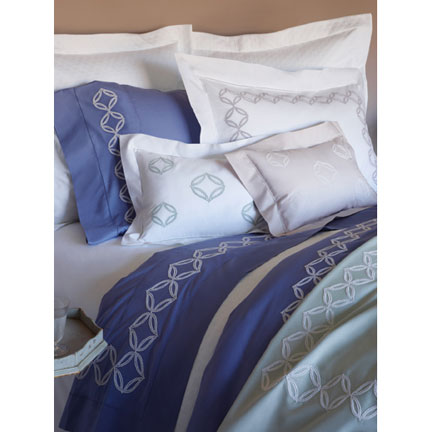
Barrington is a modern design printed atop the classic Grande Hotel collection sheeting, a best-selling crisp percale of fine Egyptian cotton. As a bold new geometric pattern, it breathes new life into a perennial Sferra favorite.
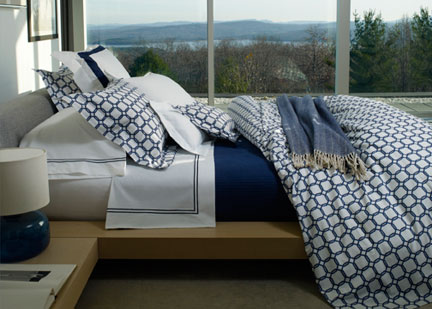
The lovely Nola pillow features three modern colors of alpaca, with an intricate crocheted embellishment.
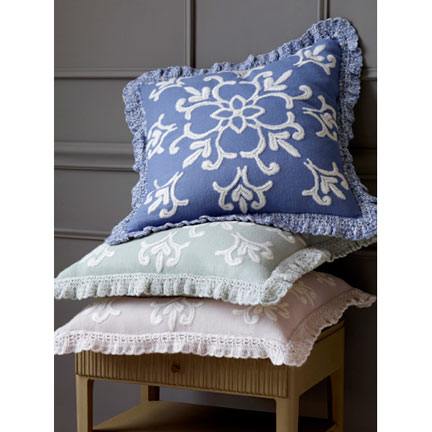
Sferra Answers: How Do I Use Euro Shams?
Question: What are Euro shams? How do I use them?
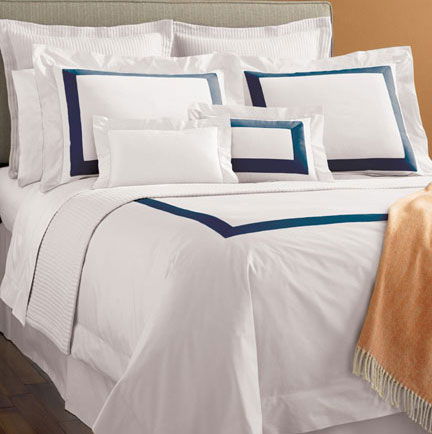
Answer: Euro shams, also known as European or Continental shams, are sized to fit a 26×26” European pillow. These pillows and shams are generally used for decorative purposes, but they can also be used as floor pillows or reading pillows. Euro shams are often designed with decorative trims or flanges, which add visual interest and increase the overall size by extending beyond the outer edge of the pillow. Unlike a pillowcase, which has the opening visible on the side, a sham has a hidden opening of overlapping fabric in the back.
The secret to setting a beautiful, luxurious bed ensemble is the layering of pillows with different sizes, shapes and patterns. In a pillow arrangement, Euro pillows are placed in the back, against the headboard, creating a background. You would generally use three Euro pillows on a king bed, two on a full or queen bed, and one on a twin bed.
In the image above, Sferra’s Euro pillows with Kendall shams are set in the back, with a layering of various styles of pillows and other sized shams in the front.
Here are a few more examples of this layering technique:
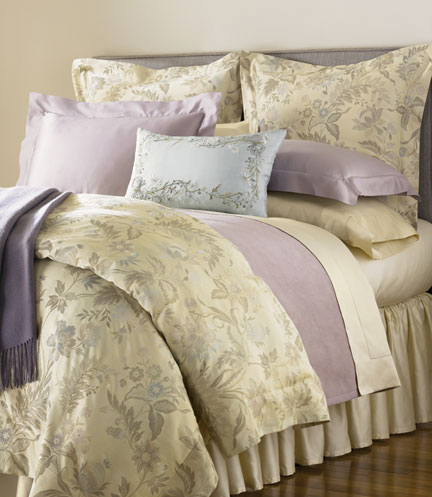
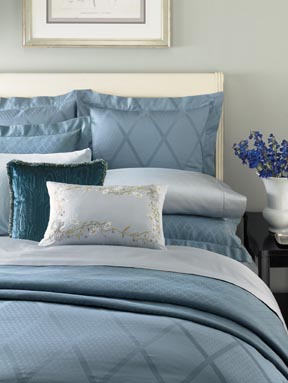
As you can see, layering with Euro and regular shams can create a lovely, textured bed ensemble. Take a look at all of our Sferra bedding options, and create a look that’s uniquely yours.
New Belgian Linens from Libeco Home
The new collections from Libeco Home have us dreaming of lazy summer days on the beach. Inspired by vintage surfboards and coastal style, we think you’re going to love these gorgeous table, kitchen and bed linens.

Malibu is a beachy bed linen collection where blue is combined with red, green and sand-colored shades brought together in a summery check. The collection includes duvet covers, pillowcases and shams. It looks great with the new Biarritz, blankets and pillow covers in blue and red.
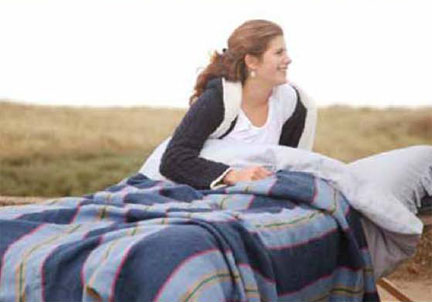
The Longboard is a 100% linen blanket inspired by vintage surfboards. Blue, red and ochre stripes run through the basic navy shade, lifting the darker base to create a blanket that’s just right for a cool summer evening. Also available in a decorative pillow cover with a zip closure.

The Lisbon collection of tablecloths, napkins and table runners brings together a playful vintage fifties look with fresh colors of rose, yellow and aqua. The darker accents lend a strong pattern.
Our best-selling Polylin table linens now feature three new summer-inspired colors: Lemon Yellow, Strawberry and Verde (a soothing aqua green.)
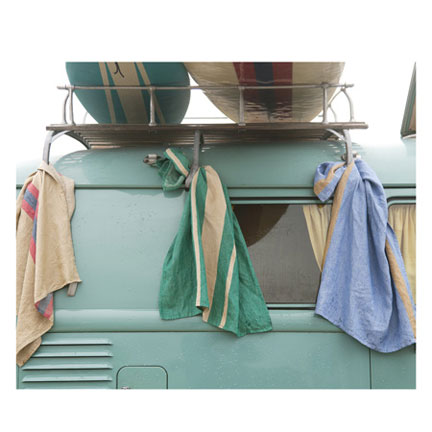
They’re a great match for the new kitchen towels, called “Waikiki“. As the name suggests, they have a young, warm and summery look inspired by the relaxed island life.
See all of our Libeco Home linen collections.
A Quick Escape From Holiday Activities
It’s the most magical time of the year – and often the most stressful. From shopping and traveling, to baking, cleaning and decorating, we have a lot to do and never enough time to do it all.
To help keep us sane, never mind in the holiday spirit, we’ve found it’s important to take some time to relax in the midst of all the bustle.
One of our favorite antidotes to holiday stress is scented candles. It only takes a minute to light a candle, and the lovely scent and soft glow set the perfect relaxing tone for the end of the day. There are so many wonderful scents to choose from –
Pumpkin Chai creates a cozy autumn ambience with a blend of wild pumpkin, spicy Masala chai, cardamom, ginger, and cinnamon.
Flowering Bamboo is mingled with a variety of white florals, sparkling citrus and fresh green accords.
Wild Oats and Bourbon is a great, non-floral scent for men. Wild oats and mandarin ginger are blended with the essence of bourbon.
The Elton John Holiday scent was designed by the artist in collaboration with NEST Fragrances. A blend of evergreen and balsam fir needles combined with rich woods and a sparkling citrus accord.
There are many more…
Scented candles are a great gift for yourself! They also make wonderful gifts for hostesses, family, friends and anyone who might be a little difficult to shop for. According to this article in the Wall Street Journal, they are a go-to gift item this season.
Our NEST candles are beautifully packaged in gift boxes for that extra touch of luxury that your gift recipients will appreciate. And they smell luxurious, too!
Books We Love: Martyn Lawrence-Bullard: Live, Love, and Decorate
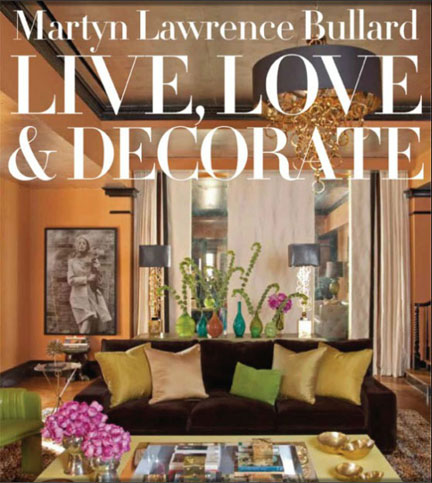
With a foreword by Sir Elton John, this book evokes luxury from the very beginning. With a knack for beautiful spaces that don’t sacrifice comfort, Lawrence Bullard-who stars in the Bravo television show Million Dollar Decorators-reveals how he creates a sensational home. The designs featured here balance the contemporary with the traditional, the occidental with the ethnic.
View more Interior Design Books at GraciousStyle.com.


